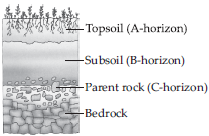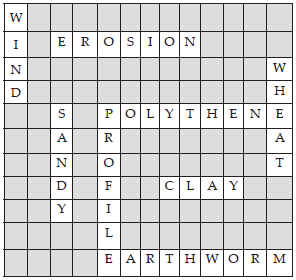Soil (Biology) Class 7 - NCERT Questions
In addition to the rock particles, the soil contains
(i) air and water
(ii) water and plants
(iii) minerals, organic matter, air and water
(iv) water, air and plants.

The water holding capacity is the highest in
(i) sandy soil
(ii) clayey soil
(iii) loamy soil
(iv) mixture of sand and loam.

Match the items in Column I with those in Column II.

(i)-b, (ii)-c, (iii)-a, (iv)-e, (v)-d
Q 4.Explain how soil is formed.
SOLUTION:The formation of soil is a long process. It begins with the breakdown of huge pieces of rocks into smaller pieces by the action of natural forces such as water, glaciers, wind, roots of plants, etc. The process is called weathering. It takes hundreds of years to breakdown rocks into fine particles that make the soil. Weathering can be of three types: physical weathering, chemical weathering and biological weathering.
Physical weathering wears down rocks into smaller particles under the influence of processes such as freezing and thawing; wetting and drying;
and shrinking and swelling. Freezing and thawing take place in cold regions where water accumulated inside the cracks of rocks freezes to ice and expands due to increase in volume. This expansion generates a pressure that breaks the rocks into smaller pieces. Chemical weathering is the decomposition of rocks through a series of chemical processes such as oxidation, reduction, hydration, etc. It is more common in warmer areas with lots of water. Some minerals dissolve in water and percolate downwards along with rain water. This changes the chemical composition of soil as compared to that of parent rock. Biological weathering is caused by living organisms such as plants and lichens. Lichens slowly decompose the rocks by secreting acids on rock surfaces. The addition of organic matter (humus) from dead and decomposed plants and animals is the last stage in the formation of soil. Thus, the process of formation of soil is influenced by climate, vegetation and parent rock to a great extent.
How is clayey soil useful for crops?
SOLUTION:Clayey soil has good water holding capacity, it is rich in humus and is fertile. Due to these characteristics, clayey soil is useful for growing crops such as paddy.
Q 6.List the differences between clayey soil and sandy soil.
SOLUTION:The differences between clayey soil and sandy soil are given below:

Sketch the cross section of soil and label the various layers.
SOLUTION:The diagram of cross section of soil showing various layers (soil profile) is as follows:

Razia conducted an experiment in the field related to the rate of percolation. She observed that it took 40 min for 200 mL of water to percolate through the soil sample. Calculate the rate of percolation.
SOLUTION:

Explain how soil pollution and soil erosion could be prevented.
SOLUTION:Soil pollution can be prevented in following ways:
(i) Waste products and chemicals should be treated before they are released into the soil.
(ii) The use of pesticides, chemical fertilizers, insecticides etc., should be minimized.
(iii) There should be a ban on polythene bags and plastics.
(iv) The trash should not be directly thrown on ground, roads, gardens etc., rather it should be thrown into dustbins.
Soil erosion can be prevented in following ways:
(i) Afforestation—Roots of the plants prevent soil erosion by firmly binding the soil particles. Thus, plantation of trees helps to prevent soil erosion.
(ii) Terrace farming—It is done in hilly areas. It consists of building a series of steps, each step slows down the flow of water, thereby reducing soil erosion.
(iii) Contour farming—It is a practice of farming which is done in hilly areas. In this practice, the crops are planted along the contour of the land. This method helps to check soil erosion by water runoff.
(iv) Preventing overgrazing—Soil erosion can also be checked by preventing the cattle from overgrazing in an area.
Solve the following crossword puzzle with the clues given:
Across
2. Plantation prevents it
5. Use should be banned to avoid soil pollution
6. Type of soil used for making pottery
7. Living organism in the soil
Down
1. In desert soil erosion occurs through
3. Clay and loam are suitable for cereals like
4. This type of soil can hold very little water
5. Collective name for layers of soil.
Across
2. EROSION
5. POLYTHENE
6. CLAY
7. EARTHWORM
Down
1. WIND
3. WHEAT
4. SANDY
5. PROFILE
